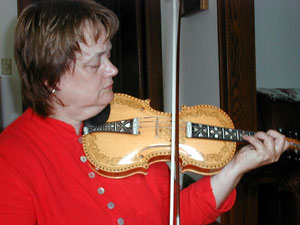|
Audio
Photos
Resources
Your Voice
|
Hardanger fiddle enthusiasts flock to Northfield
July 22, 2003
The hardanger fiddle is Norway's national instrument. To the untrained eye, it looks much like the violin. But the nine-string fiddle produces its own distinctive sound. That sound and the instrument will be celebrated this week at St. Olaf College in Northfield. More than 300 hundred Hardanger enthusiasts are expected to attend.
Northfield, Minn. — When Norwegian immigrants began fanning out across the Midwest in the mid-19th century, many brought their Hardanger fiddles. Those immigrants' children and grandchildren were less keen on the instrument, particularly as they assimilated into American society. By World War II, the hardanger was a rarity in the U.S.
Today, thanks largely to the work of the Hardanger Fiddle Association of America, it's making a comeback. No one has been more influential in this resurgence than Andrea Een. She's a hardanger fiddler extraordinaire and a well-known music professor at St. Olaf College.
Surrounded by fiddles in her Northfield living room, Een begins to describe how the Hardanger is different from the violin.
"The strings are thinner and the wood is thinner and everything is set for a brilliant, high, and very free sort of silvery sound," says Een. "It's a very different sound you're going for compared to the darkness and richness of the violin."
 | |||
She picks up a favorite and begins to play a waltz.
The hardanger is shaped like a typical fiddle, but it's ornately decorated. A delicately drawn rose pattern spreads around the instruments face. It's drawn in india ink, which stands out against the glowing, varnished wood. Inlaid mother of pearl shines along the neck. But the real difference between the hardanger and the violin is the strings. There are four long strings that are stretched much like a violin. But underneath exists five smaller strings which sound in sympathetic resonance.
"That means when I bow this string I not only get that string but also this string underneath, that's tuned to the same note," Een explains, using her instrument to demonstrate.
The resonating strings give the hardanger its characteristic full sound.
Een became intrigued by the hardanger fiddle as student at the University of Illinois. She was looking for a dissertation subject when she came across some old Hardanger recordings. She'd never heard the instrument before but something clicked. She learned how to play the fiddle and Een's been passionately promoting the hardanger ever since.
 | |||
"Finally I had a chance to go to Norway with the Salem orchestra in 1979," says Een. "I stayed on and went to my first fiddle contest and I was thrilled to see hundreds of people playing and the dances that went with it."
Since that time she's paid many visits to Norway. She stays in the old farmhouse where her grandfather was raised. Her days are filled with studying the hardanger with her fiddle mentor Lars Skjervheim.
Een's playing is not restricted to classics, she's a composer in her own right. She plays a song entitled Silver Bridal March, which was put together in honor of her fiddle instructor on his 20th wedding anniversary.
There will be plenty of playing and dancing over the next few days in Northfield. It's fitting that St. Olaf College host what Norwegian's would call the 'hardanger stevne' or reunion. It's the only college in the country to offer a credit course in the hardanger. The 20th anniversary celebration of the Hardanger Association of America continues through the weekend.
|
News Headlines
|
Related Subjects
|

